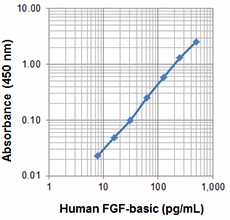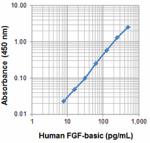- Clone
- BHFB15 (See other available formats)
- Regulatory Status
- RUO
- Other Names
- Fibroblast Growth Factor-basic, bFGF, FGF-2, FGF2, Heparin-binding growth factor
- Isotype
- Mouse IgG1, κ
- Ave. Rating
- Submit a Review
| Cat # | Size | Price | Quantity Check Availability | Save | ||
|---|---|---|---|---|---|---|
| 514801 | 50 µg | $106 | ||||
| 514802 | 500 µg | $282 | ||||
Fibroblast growth factor-basic (also known as FGF-b, FGF-2) is a heparin-binding growth factor, which stimulates the proliferation of a wide variety of cells including mesenchymal, neuroectodermal, and endothelial cells. FGF-basic also exerts a potent angiogenic activity in vivo. FGF-basic has been isolated from neural, pituitary, adrenal cortex, and placental tissues. The BHFB15 antibody reacts with human fibroblast growth factor - basic (FGF-basic).
Product DetailsProduct Details
- Verified Reactivity
- Human
- Antibody Type
- Monoclonal
- Host Species
- Mouse
- Immunogen
- Recombinant human FGF-basic.
- Formulation
- Phosphate-buffered solution, pH 7.2, containing 0.09% sodium azide.
- Preparation
- The antibody was purified by affinity chromatography.
- Concentration
- 0.5 mg/ml
- Storage & Handling
- The antibody solution should be stored undiluted between 2°C and 8°C.
- Application
-
ELISA Capture - Quality tested
- Recommended Usage
-
Each lot of this antibody is quality control tested by ELISA assay. For ELISA capture applications, a concentration of 2 µg/ml of the capture antibody was utilized to generate the example standard curve. It is recommended that the reagent be titrated for optimal performance for each application.
- Application Notes
-
ELISA Capture: The purified BHFB15 antibody is useful as the capture antibody in a sandwich ELISA assay, when used in conjunction with the biotinylated JKFb-2 antibody as the detecting antibody.
- RRID
-
AB_2561316 (BioLegend Cat. No. 514801)
AB_2561317 (BioLegend Cat. No. 514802)
Antigen Details
- Structure
- 17.2 kD (Mammalian)
- Distribution
-
Brain, retina, pituitary, kidney, placenta, testis, corpus luteum, adrenal glands, monocytes, prostate, bone, liver, cartiliage, endothelial cells, and epithelial cells.
- Function
- Released after tissue injuries and during the inflammatory process.
- Interaction
- Fibroblasts, myobalasts, osteoblasts, neuronal cells, endothelial cells, kerintocytes, chrondrocytes, astrocytes, oligodendrocytes, and the smooth muscle.
- Ligand/Receptor
- FGFR1-1 (flg); FGFR-2 (bek, K-sam); FGFR-4 (flig-2); low affinity coreceptor heparin sulfate, and heparin sulfate proteoglycans required for full activity.
- Cell Type
- Monocytes, Epithelial cells, Endothelial cells
- Biology Area
- Angiogenesis, Cell Biology, Immunology, Neuroscience, Synaptic Biology
- Molecular Family
- Adhesion Molecules, Cytokines/Chemokines, Growth Factors
- Antigen References
-
1. Fitzgerald KA, et al. 2013. The Cytokine Factsbook. Acadmic Press. San Diego.
2. Klagsbrun M, 1992. Semin. Cancer Biol. 3:81.
3. Goldfarb M. 1990. Cell Growth Factor. 1:439.
4. Sensenbrenner M. 1993. Prog. Neurobiol. 6:683. - Gene ID
- 2247 View all products for this Gene ID
- UniProt
- View information about FGF-basic on UniProt.org
Related FAQs
Other Formats
View All FGF-basic Reagents Request Custom Conjugation| Description | Clone | Applications |
|---|---|---|
| Purified anti-human FGF-basic | BHFB15 | ELISA Capture |
Compare Data Across All Formats
This data display is provided for general comparisons between formats.
Your actual data may vary due to variations in samples, target cells, instruments and their settings, staining conditions, and other factors.
If you need assistance with selecting the best format contact our expert technical support team.

 Login/Register
Login/Register 












Follow Us